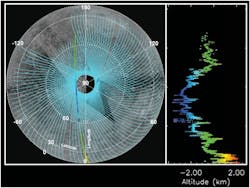Mercury Messenger's laser altimeter (MLA) getting to know Mercury's shape
Washington, DC--NASA's Mercury Messenger spacecraft, launched in 2004 and which has been orbiting the planet Mercury since March 18 of this year, is carrying a wealth of optical instrumentation. The systems include the Mercury Dual Imaging System (MDIS; which carries wide- and narrow-angle cameras and captures images in monochrome, color, and stereo in the 395 to 1040 nm wavelength band); an x-ray spectrometer, a gamma-ray (and neutron) spectrometer; and the Mercury Laser Altimeter (MLA).
All systems are go; in addition to the spectacular photos taken by Messenger, the NASA team, including Johns Hopkins University (Laurel, MD) and the Carnegie Academy for Science Education (Washington, DC) recently released news that the MLA is doing well and accumulating essential data.
MLA is key to determining Mercury's shape
In its first two months of operation, MLA has already built up a grid of ground tracks that span most of Mercury's surface north of the equator (see figure). These data will provide a very good measure of the shape of the planet's northern hemisphere, revealing information on the interior dynamical and geological processes that have modified the planet's surface.
Signals from MLA's laser reflected from Mercury's surface can be recovered whenever the spacecraft is within a range of about 1800 km from the ground track. Because of Messenger's highly elliptical orbit, MLA can make measurements only for a portion of each orbit approximately centered on closest approach.
A synergy of instruments
By far the most accurate instrument on Messenger for determining the shape of Mercury, MLA is yielding precise topographic measurements of Mercury's northern hemisphere, but other techniques must be employed to measure the shape of the southern hemisphere. These complementary techniques include the creation of 3D terrain models from stereo images obtained with Messenger's MDIS, radio occultations, and MDIS profiling of the planet's limb.
The Messenger spacecraft conducts stereo imaging by photographing regions of Mercury's surface at more than one viewing geometry; a computer algorithm then constructs a map of the 3D terrain. The shape of the planet's southern hemisphere can also be determined by capturing images of the planet's limb with MDIS.
Because the MLA data are highly accurate, they can be used to calibrate data obtained by other techniques. For example, in Mercury's northern hemisphere, a precise measurement from MLA can be used to fix portions of a topographic map created from stereo imaging or to sharpen estimates of local radius obtained from occultations or limb profiling. Such results can then be extrapolated to the southern hemisphere, where MLA data are not available.
By combining stereo-derived topographic models, radio occultation measurements, and limb profiles with MLA observations, the Messenger science team will accurately determine the global shape of Mercury.
Source: NASA

John Wallace | Senior Technical Editor (1998-2022)
John Wallace was with Laser Focus World for nearly 25 years, retiring in late June 2022. He obtained a bachelor's degree in mechanical engineering and physics at Rutgers University and a master's in optical engineering at the University of Rochester. Before becoming an editor, John worked as an engineer at RCA, Exxon, Eastman Kodak, and GCA Corporation.
